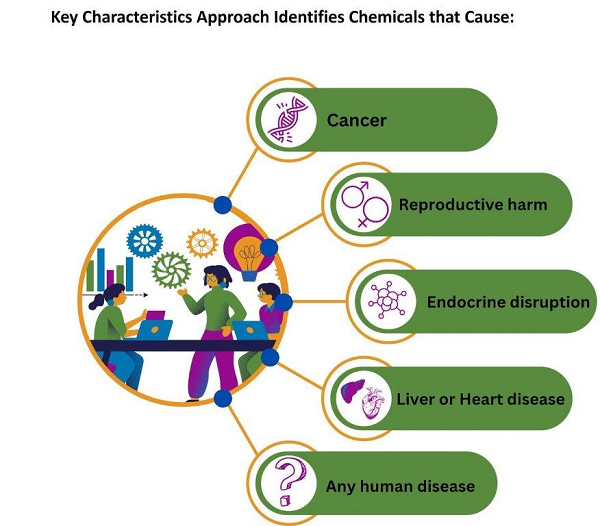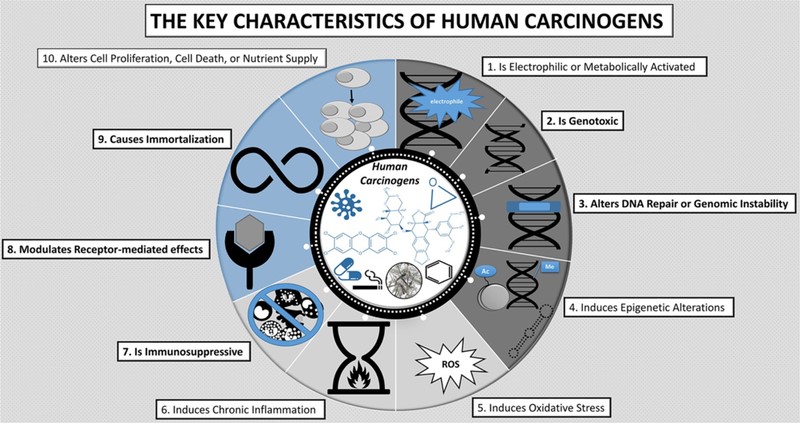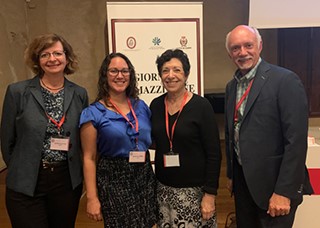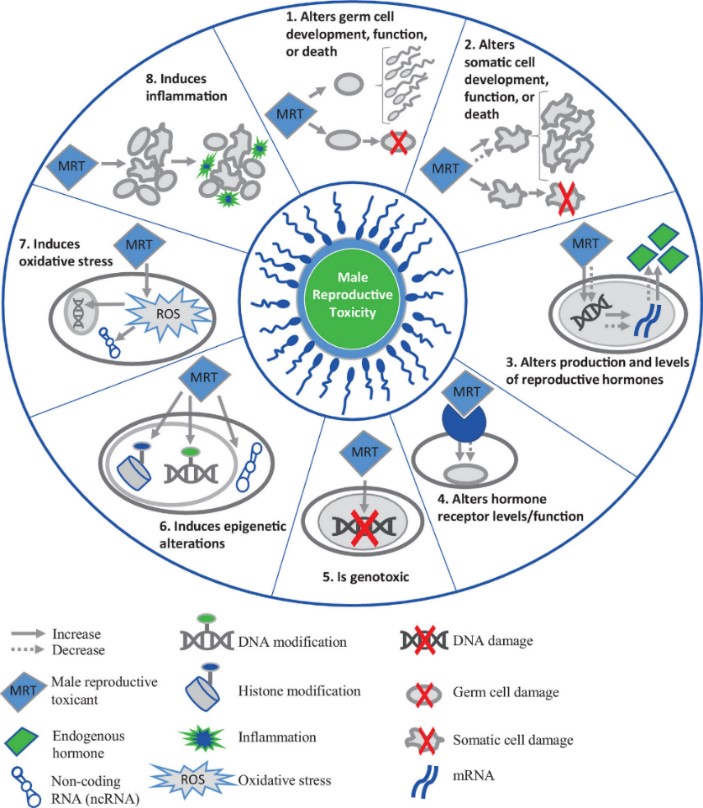NIEHS-funded University of California, Berkeley Superfund Research Program Center (UC Berkeley SRP Center) researchers and collaborators developed a new approach to help risk assessors predict the toxicity of chemicals based on shared characteristics. The approach allows for identification of the events, or key characteristics, that are shared by chemicals with similar toxic effects.
Called the key characteristics approach, the method helps risk assessors more easily identify, organize, and summarize the potential health risks of many different chemicals. By defining specific molecular changes that lead to toxicity, the approach also helps decision makers prioritize resources for studying potentially chemicals more closely.

The infrastructure and decades of risk assessment expertise provided by UC Berkeley SRP Center researchers served as the springboard for development of the key characteristics approach, which was led by Center Director Martyn Smith, Ph.D. Their expertise, combined with the Center’s experience engaging communities affected by hazardous exposures and know-how in communicating with stakeholders, played a fundamental role in forming a multidisciplinary team for the key characteristics approach.
This team included experts from 35 academic and research organizations, five U.S. government agencies, two intergovernmental agencies, three SRP Centers, and three pharmaceutical companies. This diverse collaboration provided perspectives and insight from a range of stakeholders throughout the process, ensuring the team developed a useful and practical tool for risk assessors.
The Problem
Using existing analytical methods and approaches, it would be time consuming and expensive to test the many thousands of chemicals in use for potentially harmful effects in humans. For example, studying the health effects resulting from exposure to chemicals in human populations can take years or decades, particularly for diseases that take a long time to manifest, like cancer.
Mechanistic studies and initiatives like the Toxicology in the 21st Century program (Tox21) generate large amounts of data that can help researchers better understand how chemicals affect human health. Tox21, a collaboration among NIEHS, the National Toxicology Program (NTP), the National Center for Advancing Translational Sciences, the National Center for Computational Toxicology, the U.S. Food and Drug Administration, and the U.S. Environmental Protection Agency (EPA), uses robotics and high-throughput screening to rapidly assess the potential of more than 10,000 chemical substances to harm human health.
However, scientists and decision makers have been challenged by the question of how best to systematically review and evaluate the machine-scale data generated by mechanistic studies to best understand potential implications for human health.
Finding Solutions
Key Characteristics of Carcinogens as a Building Block
- Ten key characteristics of carcinogens identified
- Established utility of approach for decision making
The key characteristics approach addresses the need for a systematic method for evaluating mechanistic data to help risk assessors make decisions about chemical, physical, and biological agents that may cause cancer, collectively called carcinogens.
In 2012, the International Agency for Research on Cancer (IARC) convened two workshops in Lyon, France for experts to discuss and identify the mechanisms by which known carcinogens cause cancer.
Experts reviewed the existing literature on chemicals known to cause cancer to define the early mechanistic changes in cells and organs caused by these chemicals.
As a result of these meetings, Smith and colleagues then defined ten key characteristics shared by cancer-causing chemicals and demonstrated how they could be used to organize data on mechanisms and to inform decision-making.

(Photo courtesy of Guyton et al., Chem Res Toxicol, 2019)
Next, in collaboration with Ivan Rusyn, Ph.D., and Weihsueh Chiu, Ph.D., of the Texas A&M University SRP Center, they systematically evaluated the strengths and limitations of the approach by reviewing the available mechanistic research on 34 chemicals with different IARC cancer classifications. The researchers demonstrated strong evidence of key characteristics for many of the agents classified as carcinogenic or probably carcinogenic to humans and identified gaps in evidence for further evaluation.
Expanding to New Health Hazards

In 2019, Smith, right, organized a session on the key characteristics at Collegium Ramazzini Days in Capri, Italy. Smith, chaired the session which included talks by, from left to right, Kathryn Guyton, Ph.D., Michele La Merrill, Ph.D., and former NIEHS and National Toxicology Program Director Linda Birnbaum, Ph.D.
(Photo courtesy of UC Berkeley SRP Center)
- Working groups consider other health hazards
- Key characteristics of reproductive toxicants identified
- Key characteristics of endocrine disrupting chemicals defined
- Key characteristics of liver toxicants
- Key characteristics of chemicals that harm the cardiovascular system
Building on the successes of the key characteristics approach for carcinogens, the team began developing key characteristics for chemicals that cause other types of harm to human health. Expanding the key characteristics approach was also a recommendation of a National Academies of Sciences, Engineering, and Medicine committee on risk assessment in the 21st century.
Smith and Lauren Zeise Ph.D., head of the Office of Environmental Health Hazard Assessment in the California Environmental Protection Agency (CalEPA), brought together a team of international researchers to carry out this effort.

Working group members identified eight key characteristics of male reproductive toxicants.
(Photo courtesy of Arzuaga et al., 2019)
The collaborators convened two separate working groups to discuss the early changes in reproductive organs and cells that may represent key characteristics of chemicals that are potentially toxic to male and female reproduction. These changes include direct impacts on the ability of reproductive cells to create embryos and longer-term impacts on embryo viability or development. One of the eight key characteristics identified for male reproductive toxicants included altering the development, function, or death of sperm cells. For female reproductive toxicants, the group identified 10 key characteristics, including altering signaling or production of reproductive hormones.
Another group of experts, led by Michelle La Merrill, Ph.D., of the University of California, Davis, and Thomas Zoeller, Ph.D., of the University of Massachusetts, Amherst, evaluated mechanistic data and developed 10 key characteristics of endocrine disrupting chemicals, which mimic or interfere with hormone actions in the body. For example, two of the key characteristics defined by the group include interacting with or activating hormone receptors and altering the production of hormones. They also identified assays that could be used to assess these characteristics and identified gaps where additional validated tests are needed.
Rusyn led a working committee that defined the key characteristics of liver toxicants. The liver is a critical organ that is responsible for a vast array of important functions, including breaking down and excreting harmful or other substances, storing and metabolizing nutrients, producing hormones, and playing a role in the immune system. The twelve key characteristics of liver toxicants include causing liver cell death, creating oxidative stress, disrupting liver metabolism, and activating stress signaling pathways, among others.
Led by Smith and Lars Lind, M.D., of the University of Uppsala, Sweden, a working group including Chiu, Cliona McHale, Ph.D., of UC Berkeley, Scott Belcher, Ph.D., of North Carolina State University, and others, defined key characteristics of cardiovascular toxicants. Among the twelve key characteristics of compounds that harm the heart or vascular system are causing inflammation, altering hormone signaling, and causing heart cell injury and death.
A working group also came to a consensus on the key characteristics of compounds that harm the immune system. Altering communication between immune cells and affecting the processes involved in cell death were among the ten key characteristics they identified.

(Photo courtesy of keycharacteristics.org)
Key Characteristics Approach Informs Decision Making
- IARC Cancer Evaluations
- NTP Report on Carcinogens
- Environmental Protection Agency
IARC has successfully used this approach since 2015 to evaluate more than 50 different chemicals, including aromatic amines, and non-chemical stressors that may harm health, like night shift work, more. Other agencies worldwide are beginning to apply it.
For example, the key characteristics approach was used in evaluations of antimony trioxide and six haloacetic acids by the NTP’s Report on Carcinogens. This was the first time that key characteristics were used to support a recommendation to list chemicals in the Report on Carcinogens. Since then, NTP has also used the approach in their cancer hazard assessment report on night shift work and light at night, concluding with high confidence that persistent night shift work can cause breast cancer in women and may cause prostate cancer in men.
Similarly, the California Office of Environmental Health Hazard Assessment used the key characteristics of carcinogens to organize and evaluate mechanistic data to weigh the evidence on cancer-causing potential for several compounds, including acetaminophen, bisphenol A, and perfluorooctane sulfonic acid and related compounds. They also used the key characteristics of male reproductive toxicants to evaluate perfluorononanoic acid and related compounds.
According to Smith, the approach is being used by EPA’s Integrated Risk Information System program and by CalEPA to inform decision making.
Similarly, the pharmaceutical industry is interested in key characteristics as an approach that could reduce animal testing and improve predictive toxicology. Consulting groups have also used the approach to evaluate the mechanistic data on the carcinogenicity of sucralose, aspartame, and per- and polyfluoroalkyl substances.
What's New?
Instead of a narrow focus on specific pathways, the key characteristics approach can be a useful way to organize toxicity data that considers broad mechanistic evidence. This makes it adaptable to considering a wide range of health effects caused by harmful toxins.
Additional working groups are focusing on identifying key characteristics of chemicals that harm other parts of the body. For example, groups of experts have convened and are refining and preparing to publish on key characteristics of chemicals that harm brain and neurodevelopment and the metabolic system.
Moving forward, the working groups plan to expand their work to include key characteristics of harmful chemicals more broadly, regardless of the specific body system that is targeted, and speed up provision of scientific information for decision makers.


